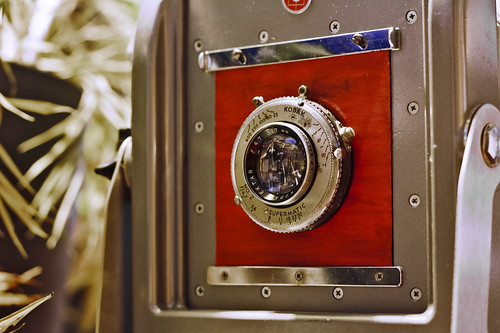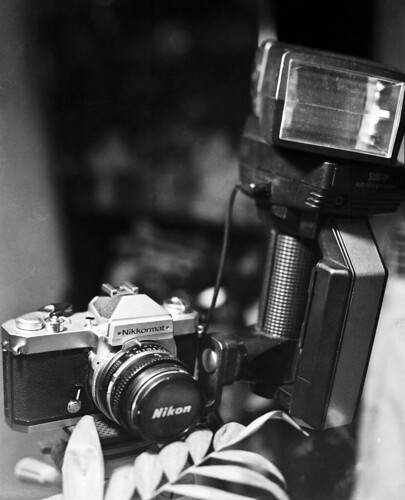 So I recently acquired a Kodak Ektar 127mm ƒ/4.7 lens for my Calumet CC400. It was had for a mere song in cost.
So I recently acquired a Kodak Ektar 127mm ƒ/4.7 lens for my Calumet CC400. It was had for a mere song in cost.The quality of this lens is just wonderful. It is a standard Tessar design, which means a 4 element in 4 group construction lens. The shutter is a Kodak Supermatic shutter with speeds of 1s to 1/400s +B +T. The only issue with this shutter is that the shutter sticks slightly from 1/10s to 1s. They are a bit longer than they should, and B and T stick as well a bit.
I didn't expect miracles for the price I paid, but the glass is spotless. There are no "cleaning" marks (small scratches) and very little dust inside the lens, which I actually was able to mostly brush out. There will be dust at some point since the lens comes apart rather easily, as it is supposed to.
The sticky shutter bothers me not at all, but the complete lack of a flash-sync doesn't sit well, except this will not be a studio lens. It's too wide.
My 210mm Schneider-Symmar will fill that role just fine, where as this lens will be delegated to outdoor use under the sun, with both B&W and Colour (E6 & C41) films.
Indoor will be used with fast film, most likely Tri-X 320 pushed to 800/1600.
As for shooting Tri-X, this camera did not disappoint at all. A sheet of Tri-X Pan 320 expired in 1972, from a 16 sheet pack film, really did well. I took it metering the entire exposure for ISO100 with a 6 second exposure under Tungsten lighting.
The image was nothing short of interesting. It's not supposed to be the most amazing image every captured on film, not in the slightest. This is just a test of the lens, and the film. Nothing more.
 Shot with my Calumet CC400 (above) and developed in Kodak TMAX developer 1+9 for 8 minutes @ 22°C it is as near perfect as I could get it. The negative is very defined, with very little base fog.
Shot with my Calumet CC400 (above) and developed in Kodak TMAX developer 1+9 for 8 minutes @ 22°C it is as near perfect as I could get it. The negative is very defined, with very little base fog.Grain is a bit more pronounced, which is expected of a film this old, but for 40 years of unknown storage, it has worked brilliantly!
I can't be happier with the purchase of this lens, nor with the purchase of this film.
I could have easily shot this with FP4+ 125 film but I think that using an expired film was the more experimental option.
I really think this film will do wonderfully under the sun instead of under Tungsten lighting, as most B&W films lose 1/3 speed under this kind of light.
Look forward to more 4x5 photographs, as I continue to explore the realm of 4x5 images, whether indoor or out.
If you are a 4x5 shooter and would love to get a wide-angle lens, don't pass up the opportunity to get your hands on a Kodak Ektar 127mm lens. They truly are a work of art.. If you can even get a Kodak Ektar Commercial lens, you'll be in for an even larger treat. They are massive lenses, and give incredible amounts of film coverage.
If you get a chance, check out the Film Photography Project (and Podcast).
Until next time, keep this shutters firing, and support Film!
Great. Fabulous to see how the 127 Ektar stands up today. My working camera at age 16 had one, and it was clearly better than the 135 Optars with the 1/1000 front shutter prized by the senior photographers. As I recall, as film passes it's use by date it gets faster and you end up in guestimate territory. Which is fine if you have a lot of stock.
ReplyDeleteActually, when film passes its date, it gets slower..
DeleteSome slow down faster than others, but ultimately all films sensitivity fades over time.
Freezing the film helps, and just slows down the process, but any film stored for extended periods of time, regardless of how, will lose sensitivity. Err, unless stored in a lead lined box in the freezer, then you'll probably have film that is as fresh as the day you bought it.
The 127mm Ektar is a great lens, and I do get a fair bit of usage out of it.
Thanks for the comment!